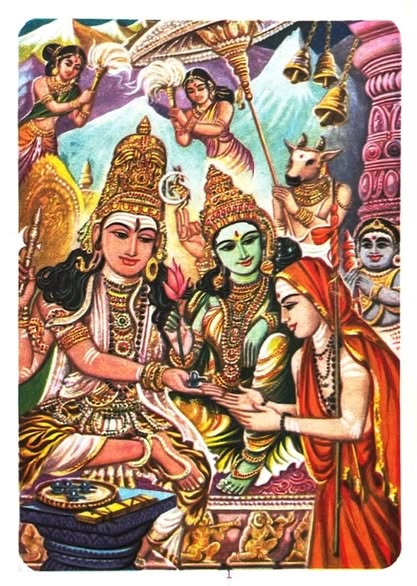-
Can Sannyasis give diksha to householders? …4

Can Sannyasis give diksha to householders? …4
மகுடாகமம் ஆசார்ய லக்ஷண விதி
-
Can Sannyasis give diksha to householders? …3
Can Sannyasis give diksha to householders? …3
ராமேஶ்வரம் திருக்கோயிலில்
மகுடாகமம் வழக்கத்தில் இருப்பதாக ஒரு சாரார் கருதுவர். காரணாகமம் என்பது அங்கிருக்கும் சிலரது கருத்து. ராமேஶ்வரம் ஆகமக் கோயில் என்று நீதிமன்ற வழக்குகளில் சிலரால் சொல்லப்பட்டதை அறநிலையத்துறையும் இதுவரை மறுக்கவில்லை. இக் கருத்து யாரால், எதனால் தற்போது முன்வைக்கப்படுகிறது? ஆகமக் கோயில் என்ற கருத்து அப்படியே ஏற்கத் தக்கதா? என்பதெல்லாம் தனித்து விவாதிக்கப்பட வேண்டியவை.
எப்படிப்பட்டவர்களை ஆசார்யர்களாக வரித்து அவர்களிடமிருந்து தீக்ஷை பெற வேண்டும் என்றும் யார் யார் ஆசார்யர்களாக இருக்கக்கூடாது, எவரிடம் தீக்ஷை பெறக்கூடாது என்றும் மகுடாகமத்தில் தெளிவாக சொல்லப்பட்டுள்ளது. இந்த ஆகமம் வைதிக பூஜை மரபு உள்ள திருக்கோயில்களில் வழங்கி வருகிறது.
ஊர்த்வ சைவர்கள் (தில்லை தீக்ஷிதர், திருப்பெருந்துறை நம்பியார், திருவானைக்கா பண்டிதர் உள்ளிட்ட ஆத்மார்த்த பரார்த்த சிவ பூஜைகள் செய்யும் அதிகாரம் கொண்ட ஸ்மார்த்த சைவ மரபினர்) குலத்தில் தோன்றி சாஸ்த்ரம் க்ரியாபாதம் முதல் ஞானபாதம் வரை நன்கு அறிந்து, தந்த்ர ஶாஸ்த்ரமும் நன்கறிந்து, உழைப்பாளியாக இருந்து, நல்ல விஷயம் தெரிந்தவராகவும் இருத்தல் வேண்டும். அதுமட்டுமன்றி அவர் க்ருஹஸ்தராக இருக்கவேண்டும். சிகை போன்றவற்றை தரித்திருக்க வேண்டும்.
இப்போது யாரை தீக்ஷை முதலியன பெறுவதற்காக ஒதுக்க வேண்டும்? அதாவது யாரிடம் தீக்ஷை பெற முடியாது என்ற பட்டியலையும் நாம் பார்க்கலாம்.
ஶாஸ்த்ரம் யோகம் அறியாதவன், நாஸ்திகன், மந்தபுத்தி உள்ளவன், ஞானமற்றவன். தீய பழக்கங்கள் உள்ளவர், பிறர் மனை விழைவோர், மற்றும் ஸந்ந்யாஸிகள் – இவர்களிடமிருந்து தீக்ஷை பெறக்கூடாது என்று தடை செய்கிறது மகுடாகமம்.
இவ்விஷயத்தில் மகுடாகமம் மட்டுமே இல்லை காரணம் போன்ற பிற சைவாகமங்களும் ஒன்றுபட்டு இப்படித்தான் சொல்கின்றன.
உண்மை இப்படி இருக்கும் பக்ஷத்தில் ராமேஶ்வரம் கோவில் அர்ச்சகர்களுக்கு துங்கா மடாதிபதிகள் தீக்ஷை கொடுப்பதற்கும் அவர்கள் கையால் தீக்ஷை பெறுவதற்கும் என்ன ப்ரமாணம் உள்ளது?
இந்த புதிய வழக்கம் ஶாஸ்த்ர விருத்தமானது; முற்றிலும் தடை செய்யப்பட்ட வேண்டியது என்பதே அறிஞர்கள் கருத்து.
ஆக, இதுதான் அங்கே ஸம்ப்ரதாயம் இதுதான் எங்கள் மரபு, கோவில் வழக்கம் என்று பலமாகக் கூவுவோர்கள் ஶாஸ்த்ர விருத்தமான கார்யங்கள் செய்கிறார்களா இல்லையா? என்பதை அவர்களுடைய நெஞ்சத்தைத் தொட்டு சொல்லட்டும். இங்கே நம்மிடம் வாதத்திற்கு வந்து பேசட்டும்.
-
Can Sannyasis give diksha to householders? …2

Can Sannyasis give diksha to householders? …2
यति ( संन्यासी), पिता, वनवासी और विविक्ताश्रमी (संसार-त्यागी) से जो दीक्षा ली जाती है, वह कल्याणदायिनी नहीं होती I
-
Can Sannyasis give diksha to householders? …1

Can a sannyasi give diksha to a householder priest according to the scriptures? If not, why is Tunga Mutt doing it in Rameshwaram?”
-
Which is the kshetra for the South?
ஒரு கேள்வி
கீழ்க்காணும் இரண்டினுள் மடாம்னாய நூல்கள் சொல்லும் தென்திசைக்குரிய க்ஷேத்ரம் எது?
ஆ. ராமேஶ்வரம்


-
கேள்வியும் பதிலும்
கேள்வியும் பதிலும்
அவர் : “மாதவீய சங்கர விஜயத்தில் ஸ்ரீசங்கராசார்ய ஸ்வாமிகளுடைய ஸித்தி ஸ்தலம் கேதாரம்; அங்கிருந்துதான் அவர் கைலாஸம் அடைந்தார் என்று ஸ்பஷ்டமாகச் சொல்லப்பட்டுள்ளது. அவர் திரும்பி வந்ததாக எந்த இடத்திலும் சொல்லவில்லை. அதனால், கேதாரம்தான் ஸித்தி ஸ்தலம். மாதவீய சங்கர விஜயத்தில் இல்லாத எதையும் நாங்கள் ஏற்க மாட்டோம்”.
இவர்: “அப்படியானால் இதற்கு பதில் சொல்லுங்கள். தமது விரிவான திக்விஜய யாத்திரையின் நிறைவாகக் கேதாரம் சென்று அங்கிருந்தே கைலாஸம் அடைந்த ஸ்ரீசங்கராசார்ய ஸ்வாமிகள் திரும்பி வரவேயில்லை என்று கதையை முடிக்கிறீர்கள்.
ஆனால், உங்களுடைய மாதவீயகாரர் சொல்லாதவை-
1. கைலாசத்தில் ஈசனாரின் அருளால் ஸௌந்தர்யலஹரிச் சுவடி அவருக்குக் கிடைத்தமை,
2. ஸ்ரீசந்த்ரமௌலீச்வர ஸ்படிக லிங்கங்களை அவர் பெற்றமை .
ஆனால், இந்த இரண்டு வரலாறுகளும் உங்களுடைய மடத்தில் பழமையாக வழங்கி வரும் ஸ்ரீசங்கராசார்ய அஷ்டோத்தர சதநாம அர்ச்சனைக் கோவையில்
सौन्दर्यलहरीमुख्यबहुस्तोत्रविधायकाय नमः
कैलासयात्रासम्प्राप्तचन्द्रमौलिप्रपूजकाय नमः
என்பனவாகக் காண்கின்றதை யாவரும் அறிவார்கள்.
ஸ்ரீஸௌந்தர்யலஹரீ ஸ்தோத்ரம், ஸ்ரீசந்த்ரமௌலீச்வர லிங்கங்கள் ஆகியவற்றை ஸ்ரீஆதிசங்கர பகவத்பாதாசார்யர் பெற்றுக் கொண்டு, கைலாஸத்திலிருந்து திரும்பி வந்தனர் என்கிற மிக முக்கியமான சங்கர விஜய வரலாற்றுச் சம்பவங்களை, அன்றாடம் உங்களுடைய வழக்கத்தில் இருக்கும் பாரம்பர்ய அர்ச்சனைக் கோவை வாயிலாக ஏற்கனவே நீங்கள் ஏற்றிருப்பதால் ஸ்ரீசங்கராசார்ய ஸ்வாமிகளுடைய ஸித்தி ஸ்தலம் கேதாரம் என்ற மாதவீய சங்கர விஜயக் கருத்தை நீங்களாகவே நிராகரித்து விட்டீர்கள். பின் எதற்கு இந்த கேதாரத்தில் ஸித்தி என்கிற நகைப்புக்குரிய வீண் வாதம்?”
மாதவீய சங்கர விஜயம் பலவற்றைச் சொல்ல விட்டிருக்கிறது.
श्रीचक्रात्मकताटङ्कतोषिताम्बामनोरथाय नमः
என்று மேற்சொன்ன அர்ச்சனைக் கோவையில் உள்ள வரலாற்றைக் காஞ்சி மடம் ஏற்கிறது. ஆனால், திருவானைக்காவில் தாடங்க ப்ரதிஷ்டை செய்த வரலாற்றை மாதவியகாரர் சொல்லவேயில்லை. அவரால் சொல்லப்படாத காஞ்சியில் ஸ்ரீகாமகோடி பீடம் ஸ்ரீமடம் ஸ்தாபனம், யோகலிங்க ப்ரதிஷ்டை, ஸர்வஜ்ஞ பீடாரோஹணம், அங்கேயே ஸித்தியுற்றது என்பனவற்றை ஏற்க மறுக்கும் நீங்கள் பிறகு ஏன் மாதவீயத்தில் இல்லாத ஜம்புகேஶ்வரம் தாடங்க ப்ரதிஷ்டை உரிமை கோரி இரண்டு நூற்றாண்டுகளாகத் தொடர்ந்து அனாவசியமாக மெனக்கெட வேண்டும்?



-
Discussion
பொது விவாதம் : கோரிக்கை
துங்கா மடம் சுவாமிகளின் சார்பில் 1844ஆம் ஆண்டு திருவானைக் கோவில் ஸ்ரீஅகிலாண்டேஶ்வரீ அம்பாளுக்குத் தாடங்க ப்ரதிஷ்டை செய்யத் தமக்கு மட்டுமே உரிமை இருப்பதாகக் கூறி திருச்சிராப்பள்ளி சதர் அமீன் நீதிமன்றத்தில் தாக்கல் செய்யப்பட்ட அசல் 95ஆம் எண் வழக்கில் கீழ்க்கண்ட இரண்டு முக்கிய வாதங்கள் ஸ்ரீசங்கர விஜயம் மற்றும் இதர தரவுகள் அடிப்படையில் அவர்களது தரப்பிலிருந்து முன்வைக்கப்பட்டன.
முதலாவது :-
கலியுகம் பிறந்து 3000 வருஷத்திற்குப் பின் விக்ரமாதித்யன் ராஜரீகத்தில் ஸ்ரீசங்கரபகவத்பாதர் கேரள தேசத்தில் அவதாரம் செய்தார்.(அதாவது கலி தொடக்கம் பொ.யு.மு. 3201இதில் 3000 ஆண்டுகள் சென்றது போக பொ.யு.மு. 201ஆம் ஆண்டு).
இரண்டாவது:-
காசியில் தம்மை தரிசித்த ஸ்ரீசங்கர பகவத்பாதாசார்ய ஸ்வாமிகளுக்கு 5 லிங்கங்களை ஸ்ரீவிஶ்வநாதர் கொடுத்தார்.
துங்கா மடம் ஸ்ரீநரசிம்ம பாரதி சுவாமிகளும் அவருடைய சிஷ்ய ப்ரசிஷ்யர்களும் இவற்றை அக்காலத்தில் மறுக்காமல் ஏற்று வந்துள்ளனர்.ஆனால், மிகச் சமீபகாலமாக ஸ்ரீசங்கராசார்யர் அவதார காலம் பொ.யு 788; அவர் ஈசனாரிடமிருந்து 4 லிங்கங்கள் மட்டுமே பெற்றார்; அவற்றை 4 ஆம்னாய மடங்களிலும் கொடுத்தார்; இவற்றுக்கு அங்கே பூஜை நடப்பதாக முற்றிலுமாக மாற்றிப் பொது ஊடகங்களில் புதுப் பிரச்சாரம் செய்வது ஏன்? ஸ்ரீபகவத்பாதாசார்யர்களின் அருள் வரலாற்றை இவ்வாறு துங்கா மடத்தினர் மட்டும் தங்கள் மனம்போனபடி மாற்றிக் கொண்டது ஏன் என்கிற விஷயத்தில் பொது விவாதம் நடத்த மாதவிய-மடாம்னாய கூட்டணி பண்டிதர்கள் முன் வருவார்களா?

-
FAQ
ஸ்ரீசங்கராசார்யர் நான்கு திசைகளிலும் திசைக்கு ஒன்றாக நான்கு மடங்களை நிறுவினார்; இவற்றுக்கு ஆம்னாய மடங்கள் என்ற விசேஷ அந்தஸ்தும் அவரால் தரப்பட்டது என்று சொல்வதற்கு எந்த சங்கர விஜய நூலில் ஆதாரம் உள்ளது?
-
Samadhisthala
Is Kedarnath the Samadhi-sthala of Pujyasri Shankara Bhagavatpadacharya?
-
FAQ
கேள்வி : சிருங்கேரி என்ற பெயரொட்டுடன் “துங்கபத்ரா தீரவாஸி” என்ற பிருது அடைமொழியைப் பயன்படுத்தி வரும் அத்வைத மடங்களுள் பூகோளரீதியாக உண்மையாகவே துங்கபத்ரை ஆற்றின் கரையில் இருக்கும் மடங்கள் எத்தனை? அவை யாவை?
பதில்: புவியியல் அடிப்படையில் இரண்டு மடங்கள் மட்டுமே உண்மையான துங்கபத்ரா தீரவாஸிகள் என்று கருதத் தக்கன.
அவையாவன, தக்ஷிணாம்னாய கூடலி சிருங்கேரி மற்றும் ஹம்பி விரூபாக்ஷ சிருங்கேரி மடங்கள் ஆகும்.
